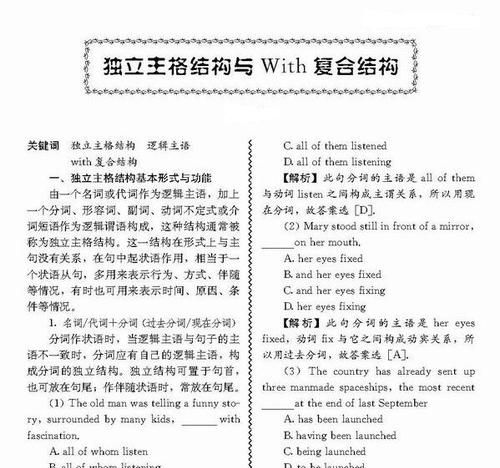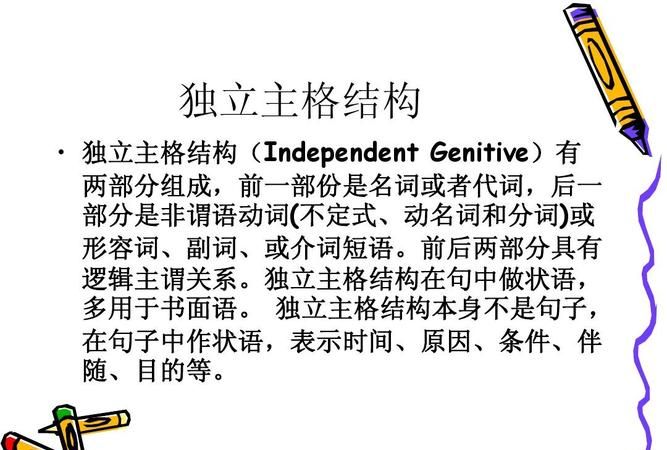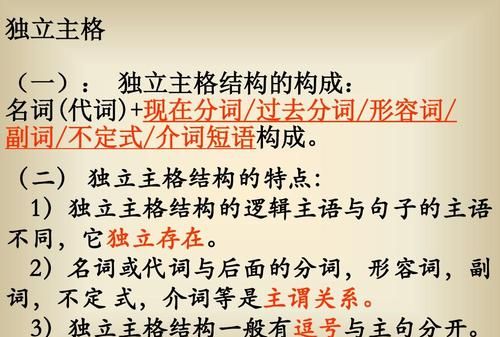本文目录
英语中的悬挂结构是什么意思
独立结构是带有自己逻辑主语的结构,又称独立主格结构。作为句子的一个语言单位,其行文简单明了,功能多样。
Ø
独立结构的形式
I.
名词(或主格结构)+动词的非谓语动词形式
Here
are
the
first
two
volumes,
the
third
one
to
come
out
next
week.
The
plan
having
been
made,
what
is
important
is
to
put
it
into
practice.
The
duty
completed,
he
had
three
months’
leave.
II.
名词(或主格代词)+形容词
He
entered
the
room,
his
nose
red
with
cold.
She
looked
at
him
expectantly,
her
eyes
full
of
excitement
and
curiosity.
III.
名词(或主格代词)+介词短语
I
stood
at
his
left,
my
finger
on
the
button,
waiting
for
the
order.
The
teacher
entered
the
classroom,
chalk
in
one
hand,
(a)
textbook
in
the
other.
IV.
名词(或主格代词)+副词
Class
over,
all
the
students
went
out
from
the
classroom.
He
put
on
his
socks,
wrong
side
out.
V.
名词(或主格代词)+名词
His
first
shot
failed,
he
fired
again.
She
sat
alone
in
the
room,
her
only
company
a
dying
fire.
注意:以上独立结构都可以看成是带being的分词复合结构的省略形式。加入being就变成了分词的复合结构。如:
Here
are
the
first
two
volumes,
the
third
one
(being)
to
come
out
next
week.
He
entered
the
room,
his
nose
(being)
red
with
cold.
I
stood
at
his
left,
my
finger
(being)
on
the
button,
waiting
for
the
order.
VI.
介词with或without引导的独立结构
这种独立结构的一般构成为:with/without+名/代词+(分词、形容词、副词、不定式、介词短语),如:
With
the
old
man
leading,
the
two
started
towards
the
mountains.
She
felt
nervous,
with
all
eyes
fixed
on
her.
Never
sleep
with
the
window
open
in
the
winter.
With
John
away,
we’ve
got
more
room.
With
five
minutes
to
go
before
the
last
train
left,
we
arrived
at
the
station.
His
wife
came
down
the
stairs,
with
her
two-year-old
son
in
her
arms.
VII.
“There
being
+名词”
结构
There
being
no
money
left,
we
have
to
change
our
plan.
There
being
no
spare
parts,
the
equipment
could
not
be
repaired
at
once.
Ø
独立结构的句法功能
独立结构在句中多作状语,表示时间、条件、原因、方式、伴随或补充说明,偶尔也作定语或主语(如最后两例句),如:
The
bell
ringing,
all
the
pupils
went
into
the
classroom.
Weather
permitting,the
football
match
will
be
played
next
Sunday.
The
question
being
rather
difficult,
we
must
take
time
to
consider
it
carefully.
The
brave
man
fought
the
man-eating
tiger,
a
stick
his
only
weapon.
How
can
I
work
with
you
making
all
that
noise?
The
war
was
over,
without
a
shot
being
fired.
A
little
boy
with
two
of
his
front
teeth
missing
ran
into
the
room.
Jenny
in
trouble
was
the
reason
for
my
rushing
there.

英语中什么叫独立结构
独立主格
一、 独立主格结构的含义和实质
“独立主格结构”(absolute construction)又叫“独立结构”,是带有自己主语的非谓语动词分句和无动词分句。由于在语法上有自己的逻辑主语,结构上与主句不发生关系,因此传统语法叫做“独立主格结构”。其实,所谓“独立主格结构”并非真正独立,它还是一种从属分句,与主句紧密联系在一起,共同表达一个完整的意思,通常在句中起状语分句的作用。独立主格结构可放于句首、句尾,用逗号和主句隔开。
二、 独立主格结构的基本形式和功能
独立主格结构可以分为两部分:一部分是名词或代词,起逻辑主语的作用;另一部分是非谓语动词分句(现在分词、过去分词、不定式)或无动词分句(名词、形容词、副词、介词短语),表示前面名词或代词的动作或状态。
基本形式是:名词普通格/代词主格+现在分词/过去分词/不定式/名词/形容词/副词/介词短语,with引导的复合结构。
1. 名词/代词+ 现在分词
现在分词表示前面的名词或代词主动进行的动作或状态等。
例 The man lay there, his hands trembling.
So many students being absent, the meeting had to be put off.
His homework having been done, Tom went to sleep.
注:“独立结构”中的being或 having been 有时可以省去,这样就成了无动词分句或过去分词分句。
2. 名词/代词+过去分词
过去分词表示前面的名词或代词被动完成的动作或所处的一种状态。
例 The boy lay on his back, his hands crossed under his head.
The job not finished, we couldn’t see the film.
Her shirt caught on a nail, she could not move.
后面两个句子也可以看成省略掉了having been,being。如果加上,这两个句子就又变成了现在分词分句。
3. 名词/代词+不定式
不定式表示的是将来的动作。
例He suggested going for a picnic, Mary to provide the food.
These are the first two books, the third one to come out next month.
We shall get together at 7:30, the procession(游行) to start moving at 8 sharp.
4. 名词/代词+名词
名词一般做前面名词或代词的同位语。
例 Many people joined in the work, some of them women and children.
He fought the tiger,a stick his only weapon.
5. 名词/代词+形容词短语
形容词(短语)说明前面名词或代词的性质,状态,原因等。
例The floor wet and slippery, we had to stay outside for a while.
I heard that she got injured in the accident, my heart full of sorry.
这两个句子也可以看成是省略了being,如果加上,就变成了现在分词分句。
6. 名词/代词+副词
副词说明前面名词或代词的状态。
例 The meeting over, we all went home.
Nobody in, he left a message on the board.
He sat at the table, head down.
7. 名词/代词+介词短语
介词短语说明伴随前面名词或代词的方式或者状态。
例 The teacher came in, a book under his arm.
The hunter entered the forest, gun in hand.
Nobody at home, the thief took a lot of things away.
8. with引导的复合结构, 也可以认为是一种独立主格结构
例 A woman got on the bus with a baby around her arms.
The teacher came in with several students following behind.
With a lot of things to deal with, he will have a difficult time.
With the work done, he went out to eat.
He left the office with the lights on.
Mary rushed out of the house with the door open.

英语独立结构的3种形式
是独立主格结构吧。
(一):独立主格的概念
“独立主格结构”是由名词或代词作为逻辑主语,加上分词、形容词、副词、动词不定式或介词短语作为逻辑谓语构成。这种结构在形式上与主句没有关系,通常称为“独立主格结构”。
(二):独立主格的功能
“独立主格结构”实质就是带有自己主语的非限定状语从句。众所周知非限定性从句通常以主句的某一成分作为自己的逻辑主语,从而依附于主句。而有些非限定性从句和无动词从句带有自己的主语,在结构上与主句不发生关系,因此成为独立主格结构。其实,虽然叫做独立主格结构,并不是真正的独立,它还是一种从属分句,在句中有多种作用。如:表原因、表条件、表方式、表伴随、表时间等,在句中通常起状语作用。
独立主格结构主要用于描绘性文字中,其作用相当于一个状语从句,常用来表示时间、原因、条件、行为方式或伴随情况等。例如:
1) 表示时间
The meeting being over, all of us went home. 开完会后我们都回家了。
Her work done, she sat down for a cup of tea. 她干完了活,坐下来喝茶。
2) 表示条件
The condition being favourable, he may succeed. 若条件有利,他或许能成功。
3) 表示原因
There being no taxis, we had to walk. 没有出租车,我们只好步行。
He wrapped her up with great care, the night being dark and frosty. 夜又黑又冷,所以他把她裹得严严实实的。
4) 表示伴随情况
Almost all metals are good conductors, silver being the best of all. 几乎所有的金属都是良导体,而银则是最好的导体。(=Almost all metals are good conductors,
and silver is the best of all.)
(三): 独立主格结构的构成:
名词(代词)+现在分词、过去分词;
名词(代词)+形容词;
名词(代词)+副词;
名词(代词)+名词
名词(代词)+不定式;
名词(代词) +介词短语构成。
(四) 独立主格结构的特点:
(1)独立主格结构的逻辑主语与句子的主语不同,它独立存在。
2)名词或代词与后面的分词,形容词,副词,不定式,介词等是主谓关系。
3)独立主格结构一般有逗号与主句分开。
The murder was brought in, with his hands ___ behind his back。
A. being tied B. having tied C. to be tied D. tied
答案D. with +名词(代词)+分词+介词短语结构。当分词表示伴随状况时,其主语常常用with来引导。由于本句中名词"手"与分词"绑"是被动关系,因此用过去分词,选D.
Weather___, we'll go out for a walk.
A permitted B permitting C permits D for permitting
答案B. 本题中没有连词,它不是复合句,也不是并列句。 句中使用了逗号,且we 小写,可知其不是两个简单句。能够这样使用的只有独立主格或with的复合结构。据此判断,本句中使用的是独立结构, 其结构为:名词+分词。 由于permit在这里翻译为'天气允许',表主动,应用现在分词,故选B。
如果不会判断独立结构作状语的形式,不妨将句子改为条件句,例如本句改为If weather permits, we'll go out for a walk. 然后将if 去掉,再将谓语动词改为非谓语动词即可。

英语中的独立结构有哪几种形式怎么用英语说
不知道你说的是不是英语当中的独立主格结构 如果是的话 那么就应该是下面的情况 下面是我上高中的时候自己总结的笔记
英语中有一种短语结构,在逻辑上他们是主语(n.pron)和谓语(分词、不定式、形容词、副词、介词短语、名词、数词)上的关系,而没有语法意义上的主语和谓语,这种结构叫做独立主格结构.这种结构在句子当中经常起状语的作用,间或作定语.有些可以转换成状语从句,表示原因、时间、方式、条件、伴随等情况.有时前面可以加介词with构成with符合短语.
构成:n./pron+ doing/ done /to do /adj /adv/prep phrase/n./num.
特点:无谓语动词,但前面的n.或pron.与后面的各种短语有逻辑上的主谓关系.
应用:多用于书面语,在描绘性文字中有时用到它来使描绘更生动.
常见类型:
1)n./pron.+ 分词 e.g.Spring coming on,the fields turn green.Mother being ill,she had to stay at home.They set out up the mountain,ropes tied to their backs.
2)名词、代词+不定式 e.g.She was left alone,with no one to look after her.
3)名词、代词+形容词 e.g.He entered the room,his nose red with cold.The man looked at the picture,with his mouth open.
4)名词、代词+副词 e.g.He put on his socks,wrong side out.The meeting over,everyone went home.With her mother away from home,she felt lonely.
5)名词、代词+介词短语 e.g.She stood under a tree,hands in her pockets.The girl entered the room,with an apple in her hand.
6)名词、代词+名词 e.g.In the north is Scotland,with its capital Edinburgh.
7)名词、代词+数词 e.g.She has two sons,one six,the other seventeen.
注:无with无须接相应的冠词和人称代词,有with时,需要将相应的冠词和人称代词还原.
e.g.The dog is walking on the bridge,with a piece of meat in its mouth.
The dog is walking on the bridge,with meat in mouth.
位置:
1、表示时间、原因、条件的状语多放在句首,有时可插在句中,可以用相应的状语从句来替代.
e.g.The work done,we felt relieved.(Since the work has been done,we felt relieved.)
They being our friends,we should help them.Weather permitting,we will go there.
2、表示方式、伴随情况的状语放在句尾,有时可以用并列句代替.
e.g.He was deep in silence,his mind working.(方式)
He went to the front door,his sons following him.(伴随)
有问题欢迎随时追问

以上就是关于英语中独立结构基本形式,英语中的悬挂结构是什么意思的全部内容,以及英语中独立结构基本形式 的相关内容,希望能够帮到您。
